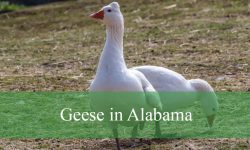When we think of big birds, our minds often jump to majestic creatures that dominate the skies with their impressive size and wingspan. Among these awe-inspiring species are the biggest birds in the world that can fly—true giants of the avian kingdom. These birds captivate birdwatchers and nature enthusiasts alike with their extraordinary abilities to soar gracefully despite their massive bodies.
Flying requires strength, endurance, and perfectly adapted anatomy, and these largest flying birds have evolved remarkable features to master the skies. From the towering Andean Condor to the graceful Wandering Albatross, each species boasts unique characteristics that enable it to glide, soar, or migrate across vast distances. Their sheer size often surprises many, challenging the common assumption that bigger birds can’t take flight.
In this article, we will explore five of the biggest birds in the world that can fly, highlighting their physical traits, behaviors, habitats, and fascinating facts. Accompanied by stunning pictures, this guide will introduce you to these magnificent creatures and reveal what makes them true rulers of the skies.
Top 5 Biggest Birds in the World That Can Fly
Andean Condor (Vultur gryphus)
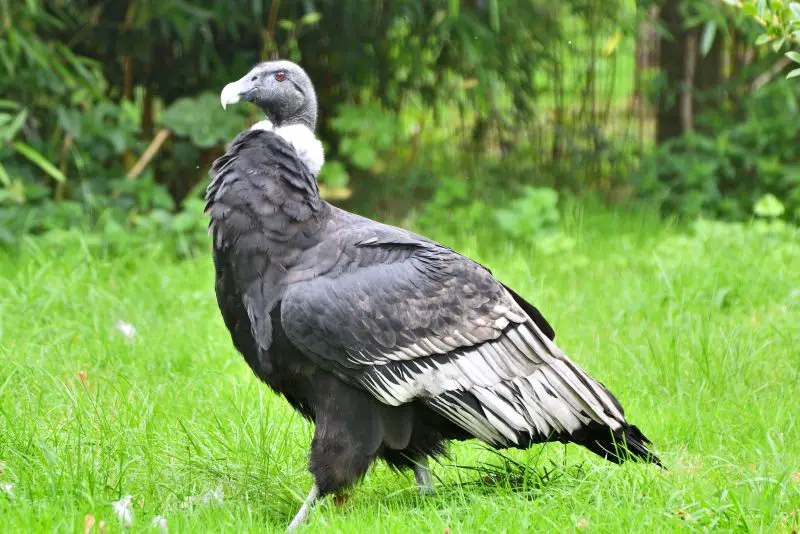
The Andean Condor is the heaviest flying bird in the world, with males weighing up to 15 kg (33 lbs). It boasts a massive wingspan of up to 3.3 meters (10.8 feet), allowing it to glide effortlessly through the high altitudes of the Andes Mountains. This impressive wingspan helps the bird stay aloft for hours without flapping its wings frequently, conserving energy during long flights.
Identifying an Andean Condor is straightforward due to its predominantly black plumage contrasted with striking white feathers on the wings and around the neck. It has a bald head with red-pink skin and a small fleshy comb on top, adaptations that help it stay clean while feeding on carrion. The size and shape make it unmistakable in its natural habitat.
These birds are scavengers and play a vital ecological role by consuming dead animals. They rely heavily on thermal air currents to soar and search for food, often flying at altitudes exceeding 5,000 meters (16,400 feet). Their ability to cover vast distances in search of carrion is a key survival trait.
A fascinating fact about the Andean Condor is its longevity—it can live up to 70 years in the wild. This bird is also culturally significant in many Andean cultures, symbolizing power and freedom. Despite their size, Andean Condors are gentle birds that prefer to avoid conflict.
Wandering Albatross (Diomedea exulans)
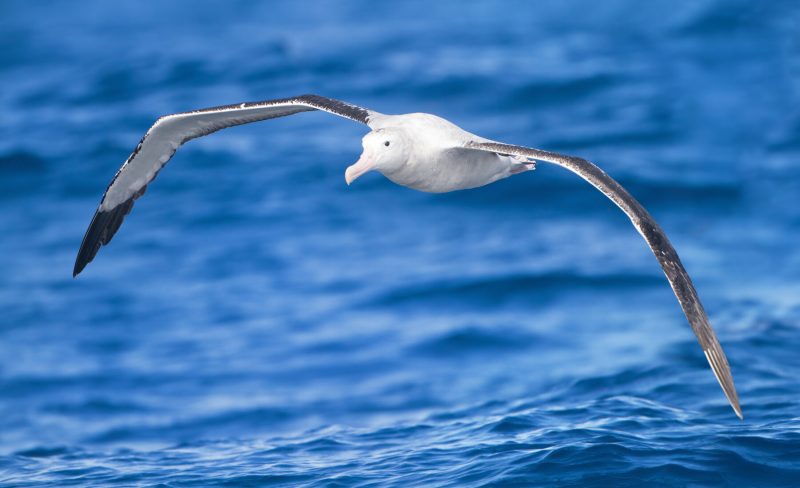
The Wandering Albatross holds the record for the largest wingspan of any living bird, measuring up to 3.5 meters (11.5 feet). This enormous wingspan allows it to glide gracefully over the Southern Ocean with minimal effort, making it one of the most efficient long-distance flyers in the bird world. It can travel thousands of miles without flapping its wings frequently.
This seabird’s plumage is mostly white with some dark patches on the wings and back, which helps with identification. Despite its large size, the Wandering Albatross is relatively lightweight, an adaptation that helps it stay airborne for extended periods. It has a large hooked beak suited for catching squid and fish.
Wandering Albatrosses spend most of their life in flight over open ocean waters, only returning to remote islands for breeding. They are excellent gliders, using wind and ocean air currents to conserve energy during their extensive journeys. These birds can fly continuously for hours or even days.
An interesting fact is that the Wandering Albatross can live more than 50 years and mates for life. Their long wingspan also makes them vulnerable to collisions with human-made structures, which is a growing conservation concern. Their graceful flight has made them a symbol of freedom on the seas.
Kori Bustard (Ardeotis kori)
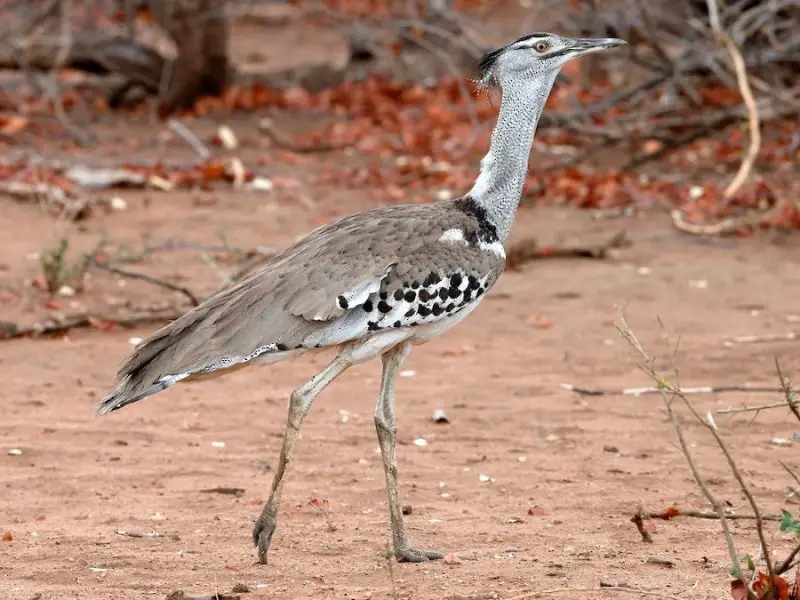
The Kori Bustard is one of the heaviest birds capable of flight, with some individuals weighing up to 18 kg (40 lbs). It has a large wingspan reaching about 2.7 meters (8.9 feet), which is impressive given its bulky body. However, this bird prefers to stay on the ground and only flies when necessary, often to escape predators.
This species has mottled gray and brown plumage that provides excellent camouflage in its native savanna habitat across sub-Saharan Africa. It has a stout neck and a heavy body, making it look more like a ground bird than a flyer. The Kori Bustard’s size and coloration help it blend into the dry grasslands.
Behaviorally, the Kori Bustard spends much of its time walking slowly in search of insects, small mammals, and seeds. When it flies, it does so with powerful wingbeats but usually avoids flying unless threatened. It is also known for its elaborate courtship displays, where males puff up and produce booming calls to attract females.
A fun fact is that despite its large size and heavy weight, the Kori Bustard can achieve flight, a rare ability among very heavy birds. This species is considered vulnerable due to habitat loss and hunting but remains a fascinating example of a giant terrestrial bird that can still take to the air.
Dalmatian Pelican (Pelecanus crispus)
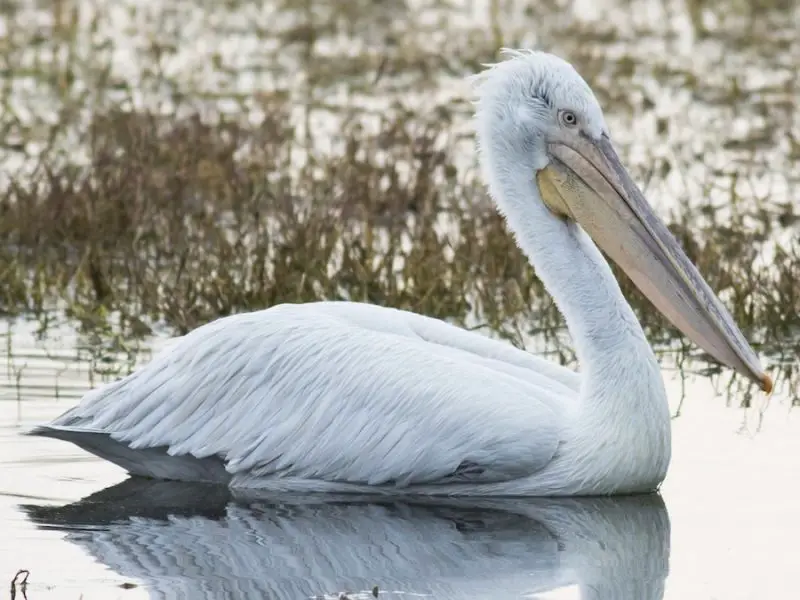
The Dalmatian Pelican is the largest flying water bird, with a wingspan reaching up to 3.5 meters (11.5 feet) and a weight of about 15 kg (33 lbs). It has a massive, heavy build adapted for life around wetlands, lakes, and rivers in Europe and Asia. Its broad wings allow it to soar gracefully while searching for fish.
This pelican has striking silvery-white to gray plumage with shaggy feathers on its head and neck, giving it a distinctive look. Its large orange bill is equipped with a throat pouch used for catching and holding fish. The Dalmatian Pelican is easier to identify during the breeding season when its plumage brightens and its bill becomes more vividly colored.
These birds often soar for long periods above water bodies, using thermal currents to aid their flight. They are social birds, frequently seen in groups, and they nest in colonies on islands or reed beds. Their diet primarily consists of fish, which they scoop up with their large bills.
An interesting fact is that Dalmatian Pelicans can dive from the air into the water to catch prey, though they mostly fish by swimming and scooping. They are considered vulnerable due to habitat degradation and disturbance, making conservation efforts important to their survival.
Trumpeter Swan (Cygnus buccinator)
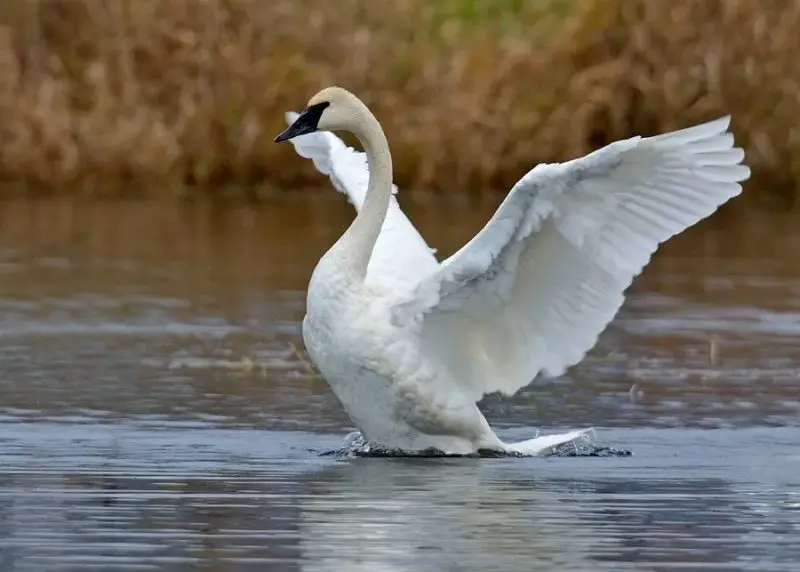
The Trumpeter Swan is the heaviest flying bird in North America, weighing up to 12 kg (26 lbs) with a wingspan of about 3 meters (10 feet). It is known for its powerful flight capabilities despite its size and weight. These swans migrate long distances seasonally, traveling between breeding and wintering grounds.
This species is easily recognized by its all-white plumage and distinctive long neck. It has a black bill shaped somewhat like a trumpet, which gives it its name. Trumpeter Swans are among the largest and most majestic waterfowl found in North America’s wetlands, lakes, and rivers.
Trumpeter Swans are strong fliers and can reach speeds of up to 60 miles per hour during migration. They often fly in V-shaped formations with their mates or family groups. Their diet includes aquatic plants, roots, and small invertebrates, which they forage from shallow waters.
A fun fact about Trumpeter Swans is that they were once near extinction due to overhunting and habitat loss but have made a remarkable recovery thanks to conservation programs. They are also known for their loud, trumpet-like calls used to communicate across long distances.
FAQs About Biggest Birds in the World That Can Fly
What are the biggest birds in the world that can fly?
The biggest flying birds include the Andean Condor, Wandering Albatross, Kori Bustard, Dalmatian Pelican, and Trumpeter Swan.
How do these large birds manage to fly despite their size?
They have large wingspans, lightweight bones, and efficient flight techniques like soaring and gliding to conserve energy.
Where do the biggest flying birds live?
These birds are found worldwide, from the Andes Mountains and African savannas to the wetlands of Europe, Asia, and North America.
What do the biggest flying birds eat?
Their diets vary: condors eat carrion, albatrosses and pelicans feed on fish, bustards eat insects and plants, and swans consume aquatic vegetation.
Are the biggest flying birds endangered?
Some species, like the Dalmatian Pelican and Kori Bustard, face threats from habitat loss and hunting, while others have stable populations.


